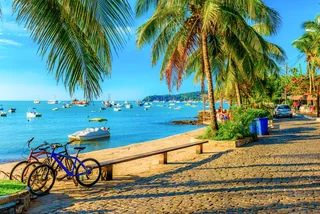Did you know that Canada lies on the Czech Republic’s southern border? Whereas Switzerland actually lies to the north? Or that Venice, so famous for flooding, sits on top of a hill? Here a Czech few places with foreign names that are definitely worth exploring.
America and Mexico

You don’t need to cross the Atlantic to find America and Mexico, for they lie just outside the village of Mořina, not far from Karlštejn castle, in the Bohemian Karst region. Velká Amerika, Mexiko, and Malá Amerika are the names given to three disused limestone quarries that were excavated here in the early part of the 20th century. The quarries are now flooded and hold clear water lakes edged with rocky cliffs, which dramatically fall away from the surrounding countryside.
Access to the quarries is a contentious issue, as they are private property and trespassing is forbidden. A plethora of signs warn visitors that they should keep out, and that the cliffs are dangerous. However, several well-worn paths behind the corden suggest that plenty of visitors ignore the warnings. To see the quarries without risking your life or a fine, simply follow the yellow-marked hiking trail, which skirts the top of the pits and connects several viewing platforms.
It’s also worth seeking out the political prisoners’ memorial that overlooks the Mexiko quarry. It commemorates the hundreds of political prisoners who were forced into hard labour here by the Communist regime between 1949 and 1953.
Getting there: Take a train from Prague hl.n to Řevnice, nám. (click the map for additional options).
Venice on the Jizera

You don’t have to cross the Alps to see Venice (Benátky in Czech), instead you can find it 40 km northeast of Prague, on the road to Mladá Boleslav. Benátky nad Jizerou is a picturesque town dominated by a castle perched high above the Jizera river. Originally a medieval stronghold, the castle was redeveloped during the Renaissance and decorated with a beautiful sgraffito facade.
One of the castle’s most famous residents was the Danish astronomer, Tycho Brache. Court astronomer and alchemist to the Emperor Rudolf II and mentor to Johannes Kepler, Brache established an observatory in the castle in 1599, where he spent a year working before moving to Prague. Brache is perhaps most famous for the method of his death, for it is suspected that he died of a burst bladder, caused by his refusal to relieve himself at a banquet held in Prague Castle -- the story goes that he was too polite to excuse himself from the table, with fatal consequences.
Aside from the castle and its beautiful gardens, cultural attractions include a regional museum and a museum of toys. The area is also popular with cyclists, and whereas you are unlikely to spot any gondoliers, you might see the occasional canoeist, gently making their way down the Jizera.
Getting there: Buses leave from Prague's Černý Most station (click the map to plan your trip).
Czech Switzerland

Bohemian Switzerland doesn’t take its name from Switzerland, at least not directly. It derives its name from Saxon Switzerland, which is in fact in Germany. Saxon Switzerland lies just across the border (a political rather than a geological boundary) in neighbouring Saxony, and was given the moniker “Saxon Switzerland” in the 18th century by two Swiss artists living in Dresden, who saw a range of flattish hills which reminded them of the Jura mountain range of their homeland. It follows then, that the hills on the Bohemian side of the border became “Bohemian Switzerland”.
Today Bohemian Switzerland is a national park consisting of beautiful walking trails through varied layers of forest, and it is very popular with both Czech and German visitors. The main attraction is the Pravčička Gate -- an awesome free-standing stone arch, which seems to defy both physics and the onslaught of erosion.
Another highlight of the national park is a trip up the Kamenice Gorges on a flat-bottomed boat. The magic here is created by the lilting boatmen, who punt their crafts along the still and silent stream. Seasoned entertainers, they delight children and adults alike by pointing out faces and animals in the rock formations, identifying fish as they swim past, and reeling off a patter of jokes in both Czech and German.
Getting there: Trains from Prague hl.n. to Děčín hl.n. (click the map for more travel options)
Czech Canada
Czech Canada is the name given to a wild and sparsely populated area that runs along the Austrian border, south of Jindřichův Hradec. Visitors can expect wide open spaces, edged by forests of pine trees and dotted with ponds, boulders and streams. It is a Czech imagining of the Canadian wilderness, but on a much smaller scale.
The name Česká Kanada was coined in 1928 by a local journalist, Jaroslav Arnošt Trpák. It was a publicity stunt, designed to attract tourists to the area, and it worked. The term caught on and was enthusiastically embraced by local officials. It entered everyday use before it was, in turn, abolished by the new Communist government. Ultimately, the passage of time and the collapse of communism ushered in the resurrection of the name in 1994, when the Czech Canada Nature Park was created.
One of the best ways to explore the area is on the narrow gauge railway, which runs between Jindřichův Hradec and Nová Bystřice. It’s one of only two narrow gauge railways still operating in the Czech Republic. The trains are old and slow, but it’s a great way of taking in the countryside at a relaxed pace. A special steam service also runs on the route -- daily in July and August, and on weekends from May to September.
Getting there: Bus or train to Jindřichův Hradec (click the map for more travel options).












 Reading time: 4 minutes
Reading time: 4 minutes 




















